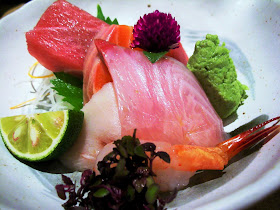 |
| Mondsee's colorful buildings |
Mondsee (Moon Lake), so named because of its crescent shape, lies in the Upper Austrian part of the Salzkammergut. Interestingly, it is one of Austria's last privately-owned lakes. In August of this year, its owner, Nicolette Waechter, announced that it was up for sale.
Sitting on the northwest corner of the lake shore is the pretty town which shares the name of the lake. The town of Mondsee, which was relatively unknown to the world, attracted international attention when it was chosen as the site for the filming of the wedding scene in 'The Sound of Music'.
A Benedictine abbey, dating from as far back as AD 748, was built here. However, when Emperor Josef II ordered the abbey dissolved in 1791, the abbey church became the Pfarrkirche or Parish Church. Another part of the abbey is now Schloss Mondsee. It was here that the filming of the wedding took place.
 |
| Pfarrkirche - the wedding in Sound of Music was shot here |
The church has an added baroque exterior. Its interior is richly decorated by Meinrad Guggenbichler, who also designed seven of the more than dozen altars spread throughout its sanctuary.
Both castle and church are, today, points of interest for tourists.
The Advent Market which is held annually during the weeks leading up to Christmas is a well-known event in the region attracting thousands of visitors each year. Even if you are not in Mondsee for its Advent Market, the place is still worth a visit for its cakes and pastries. My personal recommendation is Konditorei Frauenschuh located in the main town centre.
 |
| One of my favourite cake shops - so glad I had the chance to revisit with my darling wife |
This famous establishment, founded in the 1950s, is known by sweet lovers throughout Austria for its tempting pastries and chocolates. Once you step inside the bakery, you will be assailed by the aroma of pastries that have just been taken out from the oven and freshly ground coffee beans, not to mention the sweet smell of tarts and gateau. Its glass showcase displays racks of fruited and chocolate-covered confections for eat-in or take-away. Do not miss its apple strudel with ice cream or whipped cream, which after 5 decades, remains one of its most popular items.
Bus loads of tourists who make a perfunctory stopover in Mondsee will pack to go. If you are an indenpendent traveller, I strongly suggest taking your time to enjoy your beverage and cakes at one of its outdoor tables, and admire the Baroque facade of the Parish Church and the town centre's beautiful houses, which are painted in bright colours.
 |
| The bakery row |
Konditorei Frauenschuh has been listed in the Frommer's Best Classic Cafes in Austria, joining the ranks of establishments such as Cafe Demel, Imperial and Landtmann in Vienna, Cafe Munding in Innsbruck, and Cafe Tomaselli in Salzburg.
During Easter of 2006, I re-visited this cafe-bakery for the 4th time, even though the journey took 13 hours of flight time from Singapore to Vienna, 3 hours of train ride from Vienna to Salzburg, and another 90 minutes by bus from Salzburg to Mondsee.
The trouble that I am willing to go through just to get there goes to prove how much I love this institution of old-fashioned Austrian charm. It serves cakes and pastries that are far more imaginative, creative and delicious than the world-renown but (in my opinion) over-rated Sacher Hotel in Vienna.
Frauenschuh's apple strudel is world famous and is to die for. On this trip, however, I made the very tough decision to sacrifice it for a Layered Opera instead. But I was not at all disappointed with my choice. Darling wife's Poppy Seed Cake was unequalled in both taste and uniqueness. Laura's Banana Cream Cake was really out of this world, it was heavenly. Our ensemble of cakes made for a very pretty photograph.
 |
| The ensemble of cakes |
 |
| Black sesame cake |
 |
| Banana Chocolate Mousse cake |
We sat at one of the outdoor tables from where we could eat and drink, people-watch, and take in the sights. Since we were not in a hurry, we took things leisurely to match Mondsee's unrushed pace. We sat and stare, took in the atmosphere and completely surrendered ourselves to its laidback lifestyle.
 |
| Sipping tea and watching the world go by. |

Konditorei Frauenschuh has received rave reviews from satisfied customers hailing from all corners of the world. I have no reason to disagree.
In my journal entry, I made a note of Konditorei Frauenschuh as 'The Pride of Mondsee'.
Konditorei Frauenschuh
Marktplatz 8
Mondsee, Salzkammergut
Austria
Ambiance: 8.5/10
Service: 6/10
Food: 8.5/10
Pricing: $$
Recommended dishes: Apple Strudel, Banana Cream Cake, Layered Opera
Service: 6/10
Food: 8.5/10
Pricing: $$
Recommended dishes: Apple Strudel, Banana Cream Cake, Layered Opera
















.jpg)
.jpg)


.jpg)



















